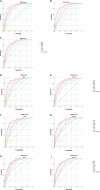Predictive ability of obesity- and lipid-related indicators for metabolic syndrome in relatively healthy Chinese adults
- PMID: 36465613
- PMCID: PMC9715593
- DOI: 10.3389/fendo.2022.1016581
Predictive ability of obesity- and lipid-related indicators for metabolic syndrome in relatively healthy Chinese adults
Abstract
Background and objective: Metabolic syndrome (MetS) is an important risk factor for cardiovascular complications and kidney damage. Obesity- and lipid-related indices are closely related to MetS, and different indices have different predictive abilities for MetS. This study aimed to evaluate the predictive value of eight obesity- and lipid-related indicators, namely, body mass index (BMI), lipid accumulation product (LAP), body roundness index (BRI), Chinese visceral adiposity index (CVAI), body adiposity index (BAI), abdominal volume index (AVI), triglyceride glucose index (TYG), and visceral adiposity index (VAI), for MetS.
Methods: A total of 1,452 relatively healthy people in Beijing were enrolled in 2016, and the correlation between the eight indicators and MetS was analyzed by multivariate logistic regression. The receiver operating characteristic (ROC) curve and the area under the curve (AUC) were used to analyze the predictive ability of the eight indicators for MetS. The Delong test was used to compare the AUC values of the eight indicators. MetS was defined according to the Chinese Guidelines for the Prevention and Treatment of Type 2 Diabetes (2020 edition), the revised National Cholesterol Education Program Adult Treatment Group (NCEP-ATPIII), and the International Diabetes Federation (IDF).
Results: Using these three sets of criteria, LAP, TYG, CVAI, and VAI, which are based on blood lipids, had higher AUC values for MetS prediction than BMI, BRI, AVI, and BAI, which are based on anthropometry. LAP had the highest AUC values of 0.893 (0.874-0.912), 0.886 (0.869-0.903), and 0.882 (0.864-0.899), separately, based on the three sets of criteria.
Conclusion: The eight obesity- and lipid-related indicators had screening value for MetS in relatively healthy people, and of the eight indicators, LAP performed the best.
Keywords: adults; healthy; lipid; lipid accumulation product; metabolic syndrome; obesity.
Copyright © 2022 Duan, Zhang, Li, Niu, Chen, Liu, Dong, Zheng, Chen, Feng, Wang, Zhao, Liu, Li, Peng, Sun, Cai, Jiang and Chen.
Conflict of interest statement
The authors declare that the research was conducted in the absence of any commercial or financial relationships that could be construed as a potential conflict of interest.
Figures

Similar articles
-
Obesity- and lipid-related indices as a predictor of obesity metabolic syndrome in a national cohort study.Front Public Health. 2023 Feb 14;11:1073824. doi: 10.3389/fpubh.2023.1073824. eCollection 2023. Front Public Health. 2023. PMID: 36875382 Free PMC article.
-
Predicting metabolic syndrome by obesity- and lipid-related indices in mid-aged and elderly Chinese: a population-based cross-sectional study.Front Endocrinol (Lausanne). 2023 Jul 28;14:1201132. doi: 10.3389/fendo.2023.1201132. eCollection 2023. Front Endocrinol (Lausanne). 2023. PMID: 37576971 Free PMC article.
-
Comparison of visceral, general and central obesity indices in the prediction of metabolic syndrome in maintenance hemodialysis patients.Eat Weight Disord. 2020 Jun;25(3):727-734. doi: 10.1007/s40519-019-00678-9. Epub 2019 Apr 9. Eat Weight Disord. 2020. PMID: 30968371
-
Effectiveness of body roundness index in predicting metabolic syndrome: A systematic review and meta-analysis.Obes Rev. 2020 Jul;21(7):e13023. doi: 10.1111/obr.13023. Epub 2020 Apr 8. Obes Rev. 2020. PMID: 32267621
-
The Accuracy of Visceral Adiposity Index for the Screening of Metabolic Syndrome: A Systematic Review and Meta-Analysis.Int J Endocrinol. 2021 Jul 26;2021:6684627. doi: 10.1155/2021/6684627. eCollection 2021. Int J Endocrinol. 2021. PMID: 34354748 Free PMC article. Review.
Cited by
-
Sex Differences in the Associations among Insulin Resistance Indexes with Metabolic Syndrome: A Large Cross-Sectional Study.Int J Endocrinol. 2024 Sep 30;2024:3352531. doi: 10.1155/2024/3352531. eCollection 2024. Int J Endocrinol. 2024. PMID: 39376492 Free PMC article.
-
Association between triglyceride-glucose related indices with the all-cause and cause-specific mortality among the population with metabolic syndrome.Cardiovasc Diabetol. 2024 Apr 24;23(1):134. doi: 10.1186/s12933-024-02215-0. Cardiovasc Diabetol. 2024. PMID: 38658993 Free PMC article.
-
Evolving perspectives on evaluating obesity: from traditional methods to cutting-edge techniques.Ann Med. 2025 Dec;57(1):2472856. doi: 10.1080/07853890.2025.2472856. Epub 2025 Mar 12. Ann Med. 2025. PMID: 40077889 Free PMC article. Review.
-
Development and visualization of a risk prediction model for metabolic syndrome: a longitudinal cohort study based on health check-up data in China.Front Nutr. 2023 Nov 21;10:1286654. doi: 10.3389/fnut.2023.1286654. eCollection 2023. Front Nutr. 2023. PMID: 38075230 Free PMC article.
-
Optimal obesity- and lipid-related indices for predicting type 2 diabetes in middle-aged and elderly Chinese.Sci Rep. 2024 May 13;14(1):10901. doi: 10.1038/s41598-024-61592-4. Sci Rep. 2024. PMID: 38740846 Free PMC article.
References
-
- Alberti KG, Eckel RH, Grundy SM, Zimmet PZ, Cleeman JI, Donato KA, et al. . Harmonizing the metabolic syndrome: A joint interim statement of the international diabetes federation task force on epidemiology and prevention; national heart, lung, and blood institute; American heart association; world heart federation; international atherosclerosis society; and international association for the study of obesity. Circulation (2009) 120(16):1640–5. doi: 10.1161/CIRCULATIONAHA.109.192644 - DOI - PubMed
-
- Angela J, Scott M, Diane B, Luther T, Richard S, Margo A, et al. . National cholesterol education program expert panel on detection, evaluation treatment of high blood cholesterol in adults. third report of the national cholesterol education program (Ncep) expert panel on detection, evaluation, and treatment of high blood cholesterol in adults (Adult treatment panel iii) final report. Circulation (2002) 106(25):3143–421. - PubMed
Publication types
MeSH terms
Substances
LinkOut - more resources
Full Text Sources
Medical
Research Materials

